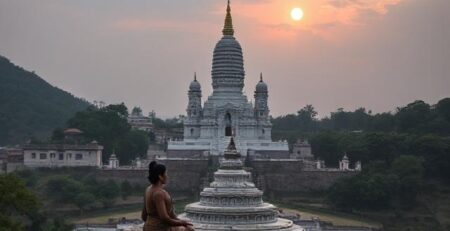Everyone Should Experience Pandharpur Wari at Least Once in Their Lifetime: The Spiritual Energy & Devotion of Ashadhi Ekadashi
Introduction
In the heart of Maharashtra, every year, a spiritual phenomenon unfolds that draws millions of devotees from all walks of life—the Pandharpur Wari during Ashadhi Ekadashi. This is not just a religious event, but a vibrant celebration of faith, unity, and devotion that leaves an indelible mark on the soul. The sheer energy, collective devotion, and cultural richness make it an experience that everyone should witness at least once in their lifetime.
The Essence of Ashadhi Ekadashi
Ashadhi Ekadashi, also known as Devshayani Ekadashi or Shayani Ekadashi, falls on the eleventh lunar day of the Shukla Paksha (bright fortnight) in the Hindu month of Ashadha (June-July). This auspicious day marks the beginning of Chaturmas, a four-month holy period when Lord Vishnu is believed to enter a cosmic slumber, symbolizing a time for spiritual renewal, self-reflection, and growth.
Spiritual Significance
The festival’s spiritual core lies in the belief that observing a fast and engaging in devotional practices on this day cleanses the soul, brings prosperity, and paves the way for spiritual advancement. Devotees believe that during Chaturmas, the divine energy of Vishnu is more accessible, making it an ideal time for introspection and spiritual practices.
“Ashadhi Ekadashi holds profound spiritual significance for Hindus. It is believed that observing a fast on this day cleanses one’s soul of past sins and paves the way for achieving spiritual growth and abundance.”
The Pandharpur Wari: A Pilgrimage Like No Other
What is the Pandharpur Wari?
The Pandharpur Wari is a centuries-old pilgrimage that culminates at the Vithoba Temple in Pandharpur, on the banks of the Chandrabhaga River. For over 700 years, millions of devotees, known as Varkaris, have undertaken this journey, often on foot, traversing hundreds of kilometers from various parts of Maharashtra and beyond.
The Journey
- Physical and Spiritual Odyssey: The Wari is not merely a physical trek; it is a profound spiritual odyssey. Pilgrims walk together, singing bhajans (devotional songs), chanting the names of Lord Vitthal (Vithoba), and immersing themselves in the collective energy of devotion.
- Unity in Diversity: The pilgrimage transcends barriers of caste, creed, and social status. Varkaris eat, sleep, and walk together, embodying the Bhakti movement’s ideals of equality, humility, and community service.
- Devotional Practices: Along the route, the air is filled with the sounds of cymbals, drums, and the chanting of “Dnyanba-Tukaram,” referencing the revered saint-poets who shaped the spiritual landscape of Maharashtra.
The Culmination: Ashadhi Ekadashi at Pandharpur
On Ashadhi Ekadashi, Pandharpur transforms into a vibrant hub of spiritual energy. The Vithoba Temple becomes the epicenter of devotion, with devotees offering prayers, performing aartis (rituals of light), and seeking blessings from the deity. The atmosphere is electric, charged with the collective faith and joy of millions.
“The town of Pandharpur, situated on the banks of the Chandrabhaga River, becomes a bustling center of devotion and festivity during this time.”
The Spiritual Energy of Pandharpur Wari
Devotion That Transcends
The Wari is a living testament to the power of Bhakti—devotion that transcends ritual and connects directly with the divine. The journey is filled with moments of hardship, but the unwavering faith of the Varkaris turns every challenge into an opportunity for spiritual growth.
Collective Consciousness
The shared experience of walking, singing, and praying together creates a powerful sense of collective consciousness. The spiritual energy is palpable, inspiring even the most casual observer to reflect on the deeper meaning of faith and community.
Cultural Heritage
The Wari is not just a religious event; it is a celebration of Maharashtra’s rich cultural heritage. Traditional music, dance, and theatre performances enliven the festivities, while spiritual leaders and scholars offer discourses that deepen the understanding of the festival’s significance.
Key Rituals and Traditions
Fasting and Prayer
Devotees observe a strict fast, refraining from grains and certain foods, dedicating the day to prayers, bhajans, and meditation. The fast is believed to purify the body and mind, making one receptive to divine blessings.
Offerings and Aartis
At the Vithoba Temple, devotees offer flowers, fruits, and other items to the deity. The aarti, performed with lamps and devotional songs, is a highlight of the celebrations, filling the temple with light and music.
Charity and Service
Acts of charity and service are integral to the Wari tradition. Pilgrims often distribute food and essentials to the needy, embodying the spirit of selfless service that is central to the Bhakti movement.
Cultural Programs
The festivities extend beyond religious rituals, featuring cultural programs that showcase the region’s artistic traditions. Music, dance, and theatrical performances bring the stories of saints and deities to life, enriching the spiritual experience.
The Bhakti Movement and Varkari Tradition
Historical Roots
The Pandharpur Wari and Ashadhi Ekadashi are deeply rooted in the Bhakti movement, which emphasized personal devotion over ritualistic practices. Saints like Sant Dnyaneshwar, Sant Tukaram, Sant Namdev, and others played a pivotal role in shaping the Varkari tradition, advocating for equality, humility, and a direct connection with the divine.
Principles of the Varkari Sect
- Devotion: Unwavering love for Lord Vitthal.
- Equality: Breaking down barriers of caste and social status.
- Community Service: Helping others as a form of worship.
- Humility: Embracing simplicity and selflessness.
The Wari is a living embodiment of these principles, offering a model for spiritual living that is as relevant today as it was centuries ago.
Why Everyone Should Experience the Wari
A Life-Changing Experience
Participating in the Wari is more than a religious act—it is a transformative journey that challenges the body, uplifts the spirit, and fosters a deep sense of connection with others. The spiritual energy, devotion, and sense of unity experienced during the pilgrimage are unparalleled.
Spiritual Awakening
The Wari serves as a catalyst for spiritual awakening, encouraging self-reflection, humility, and a renewed commitment to virtuous living. The collective devotion inspires participants to look beyond themselves and embrace the values of compassion, service, and faith.
Cultural Immersion
For those interested in Indian culture, the Wari offers a unique opportunity to witness traditional music, dance, and rituals in their most authentic form. It is a celebration of Maharashtra’s rich heritage and the enduring power of faith.
Universal Appeal
While rooted in Hindu tradition, the Wari’s message of love, unity, and selfless service resonates with people of all backgrounds. It is a reminder of the universal values that bind humanity together.
The Modern Relevance of Pandharpur Wari
Enduring Values in a Changing World
In today’s fast-paced, fragmented world, the Wari stands as a beacon of timeless values—faith, community, and service. It reminds us of the importance of slowing down, reflecting on our lives, and reconnecting with what truly matters.
Fostering Social Harmony
By bringing together people from diverse backgrounds, the Wari fosters social harmony and mutual respect. It breaks down barriers and builds bridges, creating a sense of unity that is desperately needed in contemporary society.
Practical Guide: Experiencing the Wari
When and Where
- Date: Ashadhi Ekadashi falls in June or July each year (in 2025, it is on July 6).
- Location: The pilgrimage culminates at the Vithoba Temple in Pandharpur, Maharashtra.
How to Participate
- Join a Dindi: Dindis are groups of pilgrims who walk together, often organized by local communities or spiritual groups.
- Prepare Physically: The journey can be demanding, so physical preparation is essential.
- Embrace the Spirit: Participate in singing, prayers, and acts of service along the way.
What to Expect
- Vibrant Atmosphere: Expect crowds, music, and a festive spirit.
- Simple Living: Pilgrims often sleep in tents or community halls, sharing meals and resources.
- Deep Connections: The shared experience fosters lasting friendships and a sense of belonging.
Stories from the Wari
Personal Transformations
Many participants describe the Wari as a turning point in their lives—a journey that brought them closer to the divine, deepened their faith, and inspired them to live more meaningful lives.
Inspiring Acts of Devotion
From elderly devotees walking barefoot for hundreds of kilometers to young children singing bhajans with joy, the Wari is filled with inspiring stories of devotion and resilience.
Conclusion
Everyone should experience Pandharpur Wari at least once in their lifetime. The spiritual energy, profound devotion, and sense of community make it a truly transformative event. Whether you are a seeker, a devotee, or a cultural enthusiast, the Wari offers an unparalleled opportunity to connect with the divine, immerse yourself in a rich tradition, and experience the power of collective faith.
The Pandharpur Wari and Ashadhi Ekadashi are not just festivals—they are living traditions that continue to inspire, unite, and uplift millions. In a world that often feels divided, the Wari reminds us of the enduring power of faith, the joy of community, and the beauty of devotion.
Table: Key Aspects of Pandharpur Wari & Ashadhi Ekadashi
| Aspect | Description |
|---|---|
| Primary Deity | Lord Vitthal (Vithoba), an incarnation of Lord Vishnu |
| Location | Pandharpur, Maharashtra |
| Timing | Ashadhi Ekadashi (June-July), marks start of Chaturmas |
| Pilgrimage Name | Pandharpur Wari |
| Participants | Millions of devotees (Varkaris) from all backgrounds |
| Main Activities | Walking pilgrimage, singing bhajans, fasting, prayers, charity, cultural programs |
| Core Values | Devotion, equality, humility, community service, spiritual awakening |
| Cultural Significance | Embodiment of Bhakti movement, showcases Maharashtra’s spiritual and cultural heritage |
| Modern Relevance | Fosters unity, social harmony, and spiritual renewal in a changing world |












